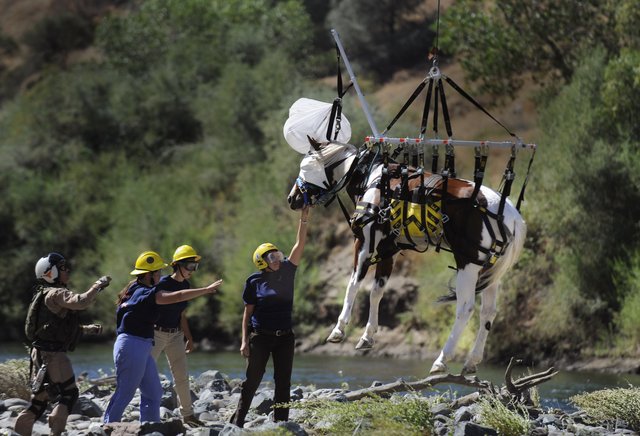by Fran Jurga | 7 October 2009 | The Jurga Report at Equisearch.com
This is not a drill. This mare was caught in the current of the American River near Sacramento, California and was unable to make her way out of a canyon under her own power. Sacramento Bee photo, from a fascinating slide show sequence.

California horsewoman Alicia Hutcheson spent the night in the bottom of a ravine in September with her mare Natasha. They weren’t exactly on a camping trip; they were waiting for a rescue helicopter to lift Natasha to safety after the mare was injured after being caught in the current of the river.
The Sacramento Bee newspaper has published a terrific slide of images that show the rescue, step by step. I hope you will take a minute to follow this link and view the slides so you can see what is involved.
The Veterinary Emergency Response Team (VERT) from the nearby University of California at Davis, fire and rescue teams, and a Navy Seahawk helicopter all coordinated their services and expertise to assist in the rescue.
Click here to read a newspaper article from the Auburn, California Journal.
This accident happened in an area where horses are very common; it is also the area where the Tevis Cup endurance ride is held each year. The proximity of the veterinary school in America best known for its rescue expertise–and which happens to employ the veterinarian who in fact invented the airlift harness–makes this a happy-ending story. I wonder how different the story might have been if it had occurred somewhere else.
How knowledgeable are the rescue crews in your area? Could a helicopter rescue at the bottom of a ravine be executed with the equipment and manpower available? Horse groups need to work with and support both human and equine emergency response crews and ambulances and sometimes even helicopters like this.
If you are interested in this subject, I highly recommend a textbook called Technical Large Animal Emergency Rescue by Gimenez, Gimenez, and May (Wiley-Blackwell Publishers, 2008). This book should be in city and town libraries wherever horses are found and should be presented as a reference to rescue departments and animal control officials. Even better, more people could attend courses in large animal emergency rescue.
It could have been any of us at the bottom of that ravine. And any of us could still be there. Alicia and Natasha got out because someone knew what to do.








